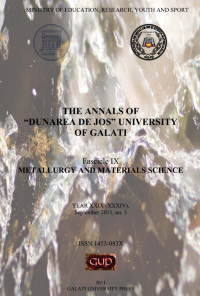A Comparative Approach of Degradative Potential of Two Different Nanophotocatalysts onto a Model Textile Dye
Abstract
Motivations and objectives. It is quite a difficult issue to treat, decolorize and mineralize textile dye waste containing dyes by conventional chemical methods (primary: adsorption, flocculation and secondary: chlorination, ozonization. It has been demonstrated that semiconductor photocatalytic oxidation of organic substances can be an alternative to conventional methods of removal of organic pollutants from water [1]. Advanced oxidation processes (AOPs) employing heterogeneous catalysis have emerged as a potentially destructive technology leading to the total mineralization of most of organic pollutants. An additional advantage of the photocatalytic process is its mild operating conditions and the fact the semiconductor can be activated by sunlight (near UV), thus reducing significantly the electric power requirement and hence the operating cost [2].
The main result and characterizing aspect of the research consist of the effectiveness of a semiconductor photocatalytic treatment of synthetic wastewater. Nanophotocatalysts ZnO have been successfully grown by hydrothermal method, onto some fibrous supports previously functionalized (grafted with MCT (monochlorotriazinyl-β-cyclodextrin, MCT-β-CD). The synthesis is reported elsewhere. The hydrothermal synthesis was performed using two types of surfactants widely used in nanoparticles preparation: Pluronic P123(triblock copolymer) and CTAB (cetyltrimethylammonium bromide). The novelty of the study consists in using these two different surfactants in growning of ZnO onto the fibrous supports. For degradation of Erionyl Roth dye, batch experiments were performed by irradiating the aqueous solution of model textile dye, containing ZnO nanocoated fibrous supports as semiconductor, in the presence of UV light. The photocatalytic process occurs under the illumination of an UV lamp, emitting light at wavelength 365 nm. The rate of decolorization was estimated spectrophotometrically from residual concentrations.
Results and discussion. The enhancement of the photocatalytic activity is attributed to the CTAB. The performance of the photocatalytic system indicated that the photodegradation of the Erionyl Roth, in the presence of CTAB, occured with a 20 % reduction of time, compared to P123.The study has demonstrated that using the semiconductor performed by CTAB on the ZnO nano-oxides synthesized onto previously MCT grafted fibrous supports is effective in degradation of dyes as well as in the treatment of textile dye waste.
Downloads
References
[2]. Tryba, B.; Morawski, A. W.; Tsumura, T.; Toyoda, M.; Inagaki, M. - J. Photochem. Photobiol., A 2004, 167, 127-135.
[3]. Li, Y. Z.; Song, J. S.; Lee, N.; Kim S. - Langmuir 2004, 20, 10838-10844.
[4]. Sun, B.; Smirniotis, P. G.; Boolchand, P. - Langmuir 2005, 21, 11397-11403.
[5]. Sakthivel, S.; Neppolian, B.; Shankar, M. V.; Arabindoo, B.; Palanichamy,M.; Murugesan, V. - Sol. Energy Mater. Sol. Cells 2003, 77, 65-82.
[6]. Khodja, A. A.; Sehili, T.; Pilichowski, J. F.; Boule, P. - J. Photochem.Photobiol., A 2001, 141, 231-239.
[7]. Sun, J. H.; Dong, S. Y.; Wang, Y. K.; Sun, S. P. - J. Hazard. Mater. 2009, 172, 1520-1526.
[8]. Yu, J. G.; Yu, X. X. Environ. Sci. Technol. 2008, 42, 4902-4907.
[9]. Ooka, C.; Yoshida, H.; Suzuki, K.; Hattori, T. - Microporous Mesoporous Mater. 2004, 67, 143-150.
[10]. Fukahori, S.; Ichiura, H.; Kitaoka, T.; Tanaka, H. - Environ. Sci. Technol.2003, 37, 1048-1051.
[11]. Zhang, G. K.; Ding, X. M.; He, F. S.; Yu, X. Y.; Zhou, J.; Hu, Y. J.; Xie, J. W. - Langmuir 2008, 24, 1026-1030.
[12]. Raveendran, P., Fu, J., Wallen, S.L. - Completely ‘‘green” synthesis and stabilization of metal nanoparticles, J. Am. Chem. Soc. 125, 13940-13941 (2003).
[13]. Vigneshwaran, N., Kumar, S., Kathe, A.A., Varadarajan, P.V., Prasad, V. - Functional finishing of cotton fabrics using zinc oxide–soluble starch nanocomposites, Nanotechnology 17, 5087-5095 (2006).
[14]. Ma, X.F., Chang, P.R., Yang, J.W., Yu, J.G. - Preparation and properties of glycerol plasticized-pea starch/zinc oxide–starch bionanocomposites, Carbohydr. Polym. 75, 472-478, (2009).
[15]. Radhakrishnan, T., Georges, M.K., Nair, P.S. - 2007. Study of sago starch–CdS nanocomposite films: Fabrication, structure, optical and thermal properties, J.Nanosci. Nanotechnol. 7, 986-993 (2007).
[16]. Jiugao, Yu, Jingwen, Yang, Baoxiang, Liu, Xiaofei, Ma - Preparation and characterization of glycerol plasticized-pea starch/ZnO–carboxymethylcellulose sodium nanocomposites, Bioresource Technology 100, 2832-2841 (2009).
[17]. F. Ollis, E. Pelizzetti, and N. Serpone - “Photocatalyzed destruction of water contaminants,” Environ. Sci.Tech., vol. 25, no. 9, pp. 1522-1529, Sept. 1991.
[18]. D. Y. Goswami - “Engineering of the solar photocatalytic detoxification and disinfection processes,” in Advances in Solar Energy, vol. 10.
[19]. K. W. Böer - Ed. Boulder: American Solar Energy Society Inc., 1995, pp.165-209.



